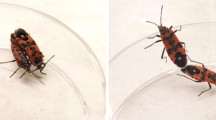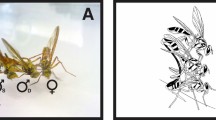Abstract
Mating between species is common, but seldom adaptive. Mate preferences and receptivity to mating attempts may both contribute to such matings, also called reproductive interference. Here, we tested the hypothesis that both male mate preference for female body size and female receptivity contribute to reproductive interference between two secondarily sympatric insect species. In north-central Florida, the squash bug Anasa tristis co-occurs with a recently introduced, smaller congener, Anasa andresii. Male A. andresii are frequently found copulating with larger female A. tristis in the field. We found that male A. andresii prefer larger heterospecific females over conspecific females, that female A. tristis accept some mating attempts by heterospecific males, and that female A. tristis are more promiscuous with conspecifics than are female A. andresii. Our findings suggest that both male mate choice and female receptivity contribute to mating between these species.




Similar content being viewed by others
References
Addesso KM, Short KA, Moore AJ, Miller CW (2014) Context-dependent female mate preferences in leaf-footed cactus bugs. Behaviour 151:479–492
Alatalo RV, Gustafsson L, Lundberg A (1994) Male coloration and species recognition in sympatric flycatchers. Proc R Soc B Biol Sci 256:113–118. doi:10.1098/rspb.1994.0057
Baranowski RM, Slater JA (1986) Coreidae of Florida (Hemiptera: Heteroptera). Florida Department of Agriculture, Bureau of Entomology, Gainesville.
Bonduriansky R (2001) The evolution of male mate choice in insects: a synthesis of ideas and evidence. Biol Rev Camb Philos Soc 76:305–339
Burdfield-Steel ER, Shuker DM (2011) Reproductive interference. Curr Biol 21:R450–R451
Byrne PG, Rice WR (2006) Evidence for adaptive male mate choice in the fruit fly Drosophila melanogaster. Proc R Soc B Biol Sci 273:917–922. doi:10.1098/rspb.2005.3372
D’Amore A, Kirby E, Hemingway V (2009) Reproductive interference by an invasive species: an evolutionary trap? Herpetol Conserv Biol 4:325–330
Dosen LD, Montgomerie R (2004) Female size influences mate preferences of male guppies. Ethology 110:245–255. doi:10.1111/j.1439-0310.2004.00965.x
Dougherty LR, Shuker DM (2014) Precopulatory sexual selection in the seed bug Lygaeus equestris: a comparison of choice and no-choice paradigms. Anim Behav 89:207–214
Edward DA, Chapman T (2011) The evolution and significance of male mate choice. Trends Ecol Evol 26:647–654. doi:10.1016/j.tree.2011.07.012
Edward DA, Chapman T (2012) Measuring the fitness benefits of male mate choice in Drosophila. Evolution 66:2646–2653. doi:10.5061/dryad.5m2671qf
Fitzpatrick BM, Shaffer HB (2007) Hybrid vigor between native and introduced salamanders raises new challenges for conservation. Proc Natl Acad Sci U S A 104:15793–15798. doi:10.1073/pnas.0704791104
Gillespie SR, Tudor MS, Moore AJ, Miller CW (2014) Sexual selection is influenced by both developmental and adult environments. Evolution 68:3421–3432
Gröning J, Hochkirch A (2008) Reproductive interference between animal species. Q Rev Biol 83:257–282
Gröning J, Lücke N, Finger A, Hochkirch A (2007) Reproductive interference in two ground-hopper species: testing hypotheses of coexistence in the field. Oikos 116:1449–1460. doi:10.1111/j.2007.0030-1299.15850.x
Hettyey A, Pearman P (2003) Social environment and reproductive interference affect reproductive success in the frog Rana latastei. Behav Ecol 14:294–300
Hochkirch A, Gröning J, Bücker A (2007) Sympatry with the devil: reproductive interference could hamper species coexistence. J Anim Ecol 76:633–642. doi:10.1111/j.1365-2656.2007.01241.x
Kishi S, Nishida T, Tsubaki Y (2009) Reproductive interference determines persistence and exclusion in species interactions. J Anim Ecol 78:1043–1049. doi:10.1111/j.1365-2656.2009.01560.x
Konuma J, Chiba S (2007) Ecological character displacement caused by reproductive interference. J Theor Biol 247:354–364. doi:10.1016/j.jtbi.2007.03.013
Kuno E (1992) Competitive exclusion through reproductive interference. Res Popul Ecol 34:275–284
Liu S, De Barro P, Xu J et al (2007) Asymmetric mating interactions drive widespread invasion and displacement in a whitefly. Science 318:1769–1772
Luddem S, Collins S, Brooks M, Winter M (2004) Some males are choosier than others: species recognition in blue waxbills. Behaviour 141:1021–1039
Miller CW, Svensson EI (2014) Sexual selection in complex environments. Annu Rev Entomol 59:427–445
Mitchell, PL (2000) Leaf-footed bugs (Coreidae). Heteroptera of economic importance, Schaefer, CW and Panizzi AR, eds. CRC Press. 337–403
Noriyuki S, Osawa N, Nishida T (2012) Asymmetric reproductive interference between specialist and generalist predatory ladybirds. J Anim Ecol 81:1077–1085. doi:10.1111/j.1365-2656.2012.01984.x
Olsson M (2013) Male preference for large females and assortative mating for body size in the sand lizard (Lacerta agilis). Behav Ecol Sociobiol 32:337–341
Pfennig KS (1998) The evolution of mate choice and the potential for conflict between species and mate-quality recognition. Proc R Soc B Biol Sci 265:1743–1748. doi:10.1098/rspb.1998.0497
Pfennig KS (2000) Female spadefoot toads compromise on mate quality to ensure conspecific matings. Behav Ecol 11:220–227. doi:10.1093/beheco/11.2.220
Pfennig KS (2007) Facultative mate choice drives adaptive hybridization. Science 318:965–967. doi:10.1126/science.1146035
Rhainds M (2010) Female mating failures in insects. Entomol Exp Appl 136:211–226
Safi K, Heinzle J, Reinhold K (2006) Species recognition influences female mate preferences in the common European grasshopper (Chorthippus biguttulus Linnaeus, 1758). Ethology 112:1225–1230. doi:10.1111/j.1439-0310.2006.01282.x
Schlaepfer M, Runge M, Sherman P (2002) Ecological and evolutionary traps. Trends Ecol Evol 17:474–480
Singer F (1990) Reproductive costs arising from incomplete habitat segregation among three species of Leucorrhinia dragonflies. Behaviour 115:188–202
Thum RA (2007) Reproductive interference, priority effects and the maintenance of parapatry in Skistodiaptomus copepods. Oikos 116:759–768. doi:10.1111/j.2007.0030-1299.15782.x
Tripet F, Lounibos LP, Robbins D et al (2011) Competitive reduction by satyrization? Evidence for interspecific mating in nature and asymmetric reproductive competition between invasive mosquito vectors. Am J Trop Med Hyg 85:265–270. doi:10.4269/ajtmh. 2011.10-0677
Verrell PA (1985) Male mate choice for large, fecund females in the red-spotted newt, Notophthalmus viridescens: how is size assessed? Herpetologica 41:382–386
Acknowledgments
We thank members of the Miller Lab of Evolutionary Ecology for assistance with insect rearing. John Capinera helped immensely locating space and facilities. We thank the University of Florida Organic Community Garden, the University of Florida Bathouse Community Garden, Crawford Organics, Swallowtail Farm, and John Steyer for allowing us to collect insects on their land. Swallowtail Farm and Crawford Organics kindly provided us with leaves and fruit for insect rearing. Funding for this study came from the National Science Foundation, Grant IOS-0926855, to CWM and the University of Florida University Scholars Program to SN.
Author information
Authors and Affiliations
Corresponding author
Additional information
Communicated by D. Gwynne
Rights and permissions
About this article
Cite this article
Hamel, J.A., Nease, S.A. & Miller, C.W. Male mate choice and female receptivity lead to reproductive interference. Behav Ecol Sociobiol 69, 951–956 (2015). https://doi.org/10.1007/s00265-015-1907-z
Received:
Accepted:
Published:
Issue Date:
DOI: https://doi.org/10.1007/s00265-015-1907-z




